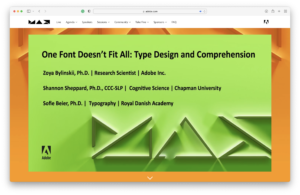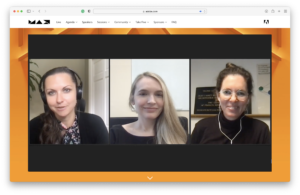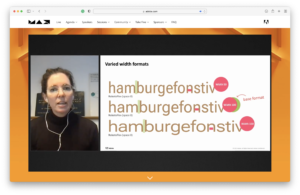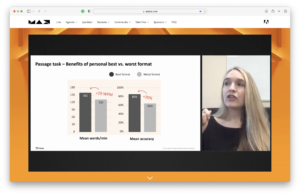Type Customization Impacts Student Comprehension
Readability Researchers from Adobe, Chapman University, and the Royal Danish Academy
Now Available on Demand
One Font Doesn’t Fit All: Type Design and Comprehension
 Zoya Bylinskii, Ph D. Research Scientist, Adobe
Zoya Bylinskii, Ph D. Research Scientist, Adobe
Dr. Shannon Sheppard, Assistant Professor of Communication Sciences and Disorders, Chapman University
Dr. Sofie Beier, Professor WSR, Head of Centre for Visibility Design, Royal Danish Academy
An innovative interdisciplinary research team recently challenged conventional wisdom by studying how type changes can impact students’ speed of reading comprehension. Explore how type customization matters.
A Quick Guide to the Highlights
Zoya led the panel discussion inviting Shannon and Sofie to describe the study they conducted with Dr. Susanne Nobles of ReadWorks. The three designed a test to look at the effect of character spacing and character width on readers in kindergarten through 8th grade.
In reviewing previous research Sofie explained the difficulty of comparing fonts given the many parameters that vary between them. This study was conducted using varried text formats of a single font, Roboto Flex.
In describing the test formats, Sofie noted that “what is interesting is what we actually did, it was very tiny changes we did to the fonts. And even in most cases, except for the extreme version, all the others have width and spacing values that equal a lot of default fonts out there. So we don’t need to make huge changes to the fonts to actually have an impact on the reader.”
Shannon presented results showing average gains in reading speed of 29 words correct per minute (22%) on the passage tasks, combined with 20% greater accuracy. She noted, “So this is really exciting because we’re finding that if you’re manipulating these really subtle features of font format, you can actually improve your comprehension.”
Shannon described the key results as (1) There is no one best format for all readers, (2) Subtle changes to text format create meaningful changes in reading speed and comprehension, and (3) Personalized formats significantly improve reading comprehension for both word and passage level reading.
Shannon observed, “Ultimately the goal is to improve reading comprehension for all, even for those who didn’t know that their reading could be improved.”
Watch the full video here.
 About Adobe MAX
About Adobe MAX
Adobe MAX 2021 – the world’s biggest creativity conference – a no-cost digital experience open to everyone worldwide! The biggest names in creativity and their newest creative cloud release came together online for a groundbreaking immersive event that stayed true to the MAX spirit of mind-blowing creativity and inspiration. Watch replays here.
 About Zoya Bylinskii Ph D., Research Scientist, Adobe
About Zoya Bylinskii Ph D., Research Scientist, Adobe
Zoya Bylinskii, Ph.D., is a Research Scientist in the Creative Intelligence Lab at Adobe Research as of 2018, and an affiliate at the Massachusetts Institute of Technology. Zoya received her Computer Science Ph.D. and M.Sc. from MIT, and an Hon. B.Sc. in Computer Science and Statistics from the University of Toronto. Zoya works at the interface of human perception & cognition, A.I., and human-computer interaction. Zoya has been actively building a readability research community, composed of perception & cognitive scientists, engineers, designers, and educators.
 About Shannon Sheppard, Assistant Professor of Communication Sciences and Disorders, Chapman University
About Shannon Sheppard, Assistant Professor of Communication Sciences and Disorders, Chapman University
Dr. Shannon M. Sheppard is an Assistant Professor of Communication Sciences & Disorders at Chapman University. Dr. Sheppard is the Director of the Cognition Rehabilitation And Neuroscience In Atypical Language Lab (CRANIAL LAB). She received her PhD in Language & Communicative Disorders from the Joint Doctoral Program at University of California, San Diego and San Diego State University. She completed her postdoctoral fellowship in the Department of Neurology at Johns Hopkins School of Medicine. The overarching aim of Dr. Sheppard’s research is to gain an understanding of brain-language relationships. This informs her work investigating how to improve language and reading comprehension in healthy populations and populations with language and reading impairments.
 About Sofie Beier, Professor WSR, Head of Centre for Visibility Design, Royal Danish Academy
About Sofie Beier, Professor WSR, Head of Centre for Visibility Design, Royal Danish Academy
Graphic designer and professor WSR Sofie Beier is employed at the Royal Danish Academy, where she is the head of Centre for Visibility Design. She is the author of the books ‘Type Tricks: Layout design’ (2021), ‘Type Tricks: Your personal guide to type design’ (2017), and ‘Reading Letters: designing for legibility’ (2012). She has further published numerous academic papers on typeface legibility. Her research is focused on improving the reading experience by achieving a better understanding of how different typefaces and letter shapes can influence the way we read.








